Prague Monuments
Château de Prague (Pražský hrad)
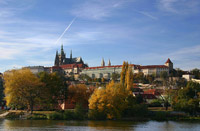
Le château de Prague (en tchèque: Pražský hrad) est le château fort où les rois tchèques, les empereurs du Saint-Empire romain germanique, les présidents de la Tchécoslovaquie, puis de la République tchèque, siègent ou ont siégé. Les joyaux de la couronne de Bohême y sont conservés. C’est peut-être le plus grand château fort par sa superficie ; il s’étend en effet sur 570 mètres de long et 130 de large.
Situé sur la colline de Hradčany et dominant la Vieille Ville de Prague et Malá Strana, cet ensemble monumental émerge d’une couronne de jardins et de toits et déploie sa longue façade …
Lire la suite
Pont Charles (Karlův most)
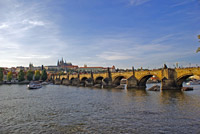
Le pont Charles (en tchèque : Karlův most) est un pont qui relie le vieux Prague (Staré Město en tchèque) au quartier de Malá Strana. Construit au XIVe siècle, il sera le seul pont sur la Vltava jusqu'en 1741.
Symbole de la ville, incontournable pour les touristes, il est envahi de musiciens, d'artistes divers, de bonimenteurs et de camelots. Son nom fait référence au roi Charles IV qui n'a eu de cesse d'embellir Prague. Sa construction a servi à remplacer l'ancien pont Judith emporté par la Vltava en crue.
Histoire
Une longue tradition attribue la construction de ce pont à …
Lire la suite
Musée national (Národní muzeum)
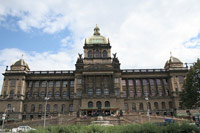
Le Musée national (en tchèque : Národní muzeum (abrégé en NM) est l'un des principaux musées de Prague. Il occupe un bâtiment néorenaissance situé en haut de la place Venceslas, la principale de Prague. Son vestibule central sert également de Panthéon aux grands hommes tchèques. František Palacký proposera la transformation du bâtiment en un nouveau musée en 1840.
Histoire
Il est fondé en 1818, par Kaspar Maria von Sternberg entre autres, en tant que Musée patriotique de Bohême (Vlastenecké muzeum v Čechách). À partir de 1848, il porte l'appellation de Musée tchèque (České muzeum), puis …
Lire la suite
Théâtre national (Národní divadlo)
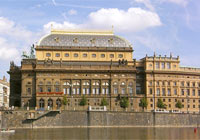
Le Théâtre national (Národní divadlo), situé à Prague est le plus célèbre théâtre de la République tchèque. Son importance culturelle et symbolique est centrale dans les cent dernières années de l'histoire la nation tchèque en particulier dans la deuxième moitié du XIXe siècle lors de la Renaissance nationale tchèque.
Histoire
Le Théâtre national est l'une des plus importantes institutions culturelles tchèques. Au milieu du XIXe siècle, alors que Prague n'est plus que la capitale des États de la couronne de Bohême depuis longtemps vassale du Saint-Empire romain germanique puis …
Lire la suite
Cathédrale Saint-Guy (Katedrála svatého Víta)
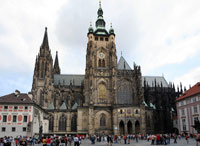
La cathédrale Saint-Guy (en Tchèque : Katedrála svatého Víta) est une cathédrale à Prague, République tchèque, et le siège de l'archevéché de Prague. Le nom complet de la cathédrale est Cathédrale Saint-Guy, Saint Venceslas et Saint-Adalbert (en Tchèque : Katedrála sv. Víta, Václava a Vojtěcha). Située à l'intérieur du Château de Prague, elle est un excellent exemple d'architecture gothique et est la plus grande et plus importante église du pays.
Origine
À l'origine de la cathédrale, il y a le présent fait aux environs de l'an 925, par le roi de Francie orientale, Henri l'Oiseleur au …
Lire la suite
Place de la Vieille-Ville (Staroměstské náměstí)
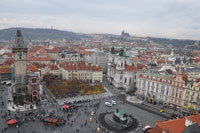
La place de la Vieille-Ville (en tchèque Staroměstské náměstí), à Prague (République tchèque), est située au cœur du centre historique de la capitale tchèque. Les bâtiments anciens, souvent très colorés, qui bordent la place lui donnent son cachet et offrent par leur architecture un raccourci de l'histoire de la cité.
L'Église de Notre-Dame de Týn
L'Église de Notre-Dame de Týn domine la place de la Vieille-Ville de ses deux tours très imposantes. Ce bâtiment gothique fut commencé en 1365 sous Charles IV. Notre Dame de Týn fut l'église des Hussites de Prague jusqu'en 1621. L'astronome …
Lire la suite
Ancien Hôtel de ville (Staroměstská radnice)
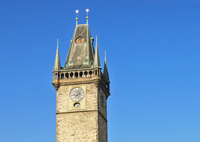
Prague's Old Town Hall was built in 1364. The astronomical clock in the town hall's tower is one of the city's most popular tourist attractions. Originally the building served only as the city hall of the old town, but later became the city hall for all of Prague. It is now only used for ceremonial functions.
The Town Hall
After King John of Luxembourg accorded the citizens of Prague the privilege of having their own district council in 1338, they decided to build a Town Hall, paid for by a duty levied on wine. The almost 70 meters high tower was completed in 1364. Due to continuous …
Lire la suite
Horloge astronomique (Staroměstský orloj)
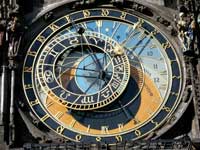
L'horloge astronomique de Prague (Pražský orloj en tchèque) est une horloge astronomique médiévale qui se trouve à Prague, capitale de la République tchèque, sur la place de la Vieille-Ville. L'horloge est située sur le mur Sud de l'hôtel de ville. Le monument a un à fort attrait touristique : dès que sonnent les heures, des centaines de personnes se pressent à ses pieds pour l'observer s'animer et la photographier.
Histoire
Elle aurait été construite par Nicolas de Kadau en 1410, et remaniée par le maître Hanus de la Rose (Jan Ruze) vers 1490. La légende veut que l’on ait crevé les …
Lire la suite
Opéra d’État (Státní opera)
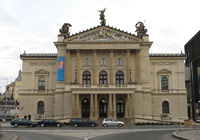
Le Státní opera Praha (Opéra d’État de Prague) est, en Tchéquie, un opéra qui abrite une troupe de ballet et d'opéra parmi les plus reconnues en Europe.
Histoire
L'histoire culturelle en général et musicale en particulier de la Bohême puis de la Tchécoslovaquie, n'aurait pas été si riche s'il n'y avait eu cette compétition rampante entre les deux nations tchèque et allemande pour la suprématie économique, politique et culturelle du pays. Avant l'édification du Théâtre national, en 1881, les artistes tchèques et allemands se partageaient le théâtre des États. Les Allemands, désireux de …
Lire la suite
Place Venceslas (Václavské náměstí)
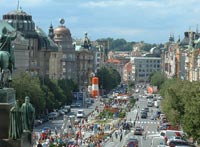
La place Venceslas (en tchèque Václavské náměstí) est, au cœur de la ville, une des places principales de Prague, en République tchèque. Elle est dédiée au saint patron du pays, Venceslas Ier de Bohême dont la statue équestre domine le haut de la place.
L'ancien marché aux chevaux ressemble aujourd'hui plus à une avenue qu'à une véritable place avec ses 750 m de long pour 60 m de large. Coeur de la vie moderne de Prague, la place a joué un rôle primordial dans l'histoire récente du pays et plusieurs événements marquants s’y sont déroulés : la déclaration de la Première République …
Lire la suite
Palais Wallenstein (Valdštejnský palác)
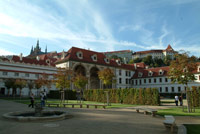
Le palais Wallenstein (en tchèque: Valdštejnský palác) est le palais, construit entre 1623 et 1630 pour Albrecht de Wallenstein, dans Malá Strana à Prague. C'est un très bel exemple d'architecture baroque dans sa première phase. Depuis 1992, il abrite le siège du sénat tchèque.
Histoire
Il est construit dans les années 1623-1630 pour Albert de Wallenstein (ou Albrecht von Waldstein), nommé général des armées impériales en 1623, prince (en 1625) puis duc (en 1627) de Friedland et (en 1629) de Mecklembourg, l'un des plus puissants et des plus riches nobles de Bohême des années troubles de …
Lire la suite
Palais Kinsky (Palác Kinských)
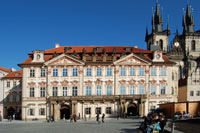
Kinsky Palace (Czech: Palác Kinských) with its beautiful pink and white stucco fasade promotes the special image of Old Town Square. It was build for Jan Arnost Goltz in 1755-65 on the place where used to stand two hotels. Goltz had the buildings rebuilt in Rococo palace with two entrances framed with two pillars. On the first floor the pillars are connected with a balcony with a balustrade.
After the death of Count Goltz, the palace was bought by Kinsky family who stayed in the palace until 1945. The palace contained a valuable family library, now it hosts collections of the National …
Lire la suite
Maison municipale (Obecní dům)
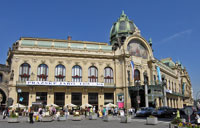
La Maison municipale (en tchèque : Obecní dům) est un complexe architectural sezessionsstil appartenant à la ville de Prague. Elle réunit une salle de concerts dédiée à Bedřich Smetana, un espace d'exposition, des salles de réception dont certaines décorées par Alfons Mucha, un café et un restaurant de style Art nouveau au rez-de-chaussée, un cocktail-bar, une brasserie et un dancing au sous-sol.
Histoire
À l'origine, à l'emplacement de la Maison municipale, se trouvait le Palais royal des souverains de Bohême dont la construction est entreprise en 1380 par Venceslas IV et qui sert …
Lire la suite
Tour Poudrière (Prašná brána)
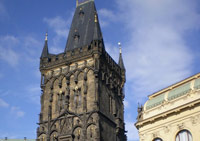
La tour poudrière est un des édifices les plus connus de la ville de Prague.
Histoire
Dès le XIe siècle, une des treize portes des fortifications médiévales de la Vieille Ville se dressait à cet endroit.
En 1445, le magistrat municipal décida d’offrir « une Nouvelle Tour » au roi Vladislav II Jagellon qui en posa la première pierre cette même année.
L’édifice, inspiré de la Tour du pont de la Vieille Ville de Peter Parler, n’avait pas de véritable fonction défensive.
Sa riche décoration sculptée devait ajouter au prestige du Palais royal adjacent qui se trouvait sur l'emplacement de …
Lire la suite
Église de Týn (Týnský chrám)
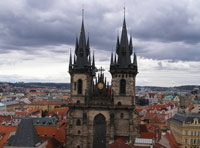
The Church of Our Lady before Týn (in Czech Kostel Matky Boží před Týnem, also Týnský chrám (Týn Church) or just Týn) is a dominant feature of the Old Town of Prague, Czech Republic, and has been the main church of this part of the city since the 14th century. The church's towers are 80 m high and topped by four small spires.
History
In the 11th century, this area was occupied by a Romanesque church, which was built there for foreign merchants coming to the near Týn Courtyard. Later it was replaced by an early Gothic Church of Our Lady in front of Týn in 1256. Construction of the …
Lire la suite
Chapelle de Bethléem (Betlémská kaple)
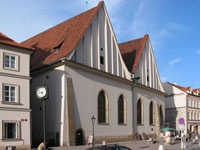
The Bethlehem Chapel (Czech: Betlémská kaple) is a medieval religious building in Prague, Czech Republic notable for its connection with the Czech reformer Jan Hus. It was opened for sermons in 1394, and taught solely in the Czech vernacular, thus breaking with German domination of the Medieval Bohemian church. The building was never officially called as a church, only a chapel.
In the 17th century, the building was acquired by the Jesuits. During reign of the Emperor Joseph II (1780s) converted into an apartment building. Under the Czechoslovakian communist regime the building was …
Lire la suite
Carolinum (Karolinum)
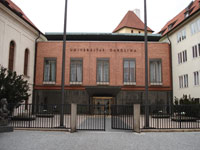
Karolinum (formerly Latin: Collegium Carolinum, in Czech Karlova kolej) is a complex of buildings located in the Old Town of the City of Prague. Karolinum, the seat of the Charles University in Prague, is one of the oldest dormitories situated in the Central Europe. The dormitory was named after the Emperor Charles IV.
History
Shortly after the establishing of Charles University in 1348, the young insititution encountered several organizational problems. One of the major complications was the lack of lecture and accommodation rooms for teachers and students. Emperor Charles IV, apparently …
Lire la suite
Clementinum (Klementinum)
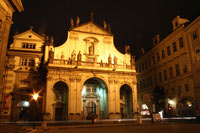
The Clementinum (Klementinum) is a historic complex of buildings in Prague. Today the complex hosts the National, University and Technical libraries, being the City Library also located nearby on Mariánské Náměstí. It is currently in use as the National Library of the Czech Republic. In 2005 the Czech National Library received the UNESCO´s Jikji prize (Memory of the World).
Its history dates from the existence of a chapel dedicated to Saint Clement in the 11th century. A Dominican monastery was founded in the medieval period, which was transformed in 1556 to a Jesuit college. In 1622 the …
Lire la suite
Rudolfinum
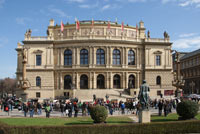
The Rudolfinum is a music auditorium in Prague, Czech Republic. It is one of the most important neo-renaissance buildings in the city and is situated at Jan Palach Square on the bank of the river Vltava.
Since 1946 the Rudolfinum has been the home-stage of the Czech Philharmonic Orchestra and one of the main venues performed in the Dvořák Hall for the Prague Spring International Music Festival held each year in May and June. The building was designed by architect Josef Zítek and his student Josef Schulz, and was opened February 8, 1885. It is named in honour of Rudolf, Crown Prince of …
Lire la suite
Jindrisska Tour (Jindřišská věž)
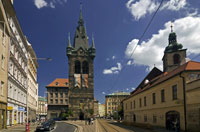
The Jindrisska Tower is a historic bell tower, first built in the 15th century. Renovated in 2001 the tower now features a restaurant and a 10th floor lookout where you have great views over the city.
History
At 65.7 meter (216 ft), the Jindrisska Tower is the tallest free-standing bell tower in Prague. Its history goes back to 1475 when it was built in wood as the bell tower of the Church of St. Henry and Kunhuta (kostel sv Jindrich a Kunhuty), the parish church of New Town.
The current stone version was built at the end of the 16th century. The tower was damaged several times, first …
Lire la suite
Basilique de Saint Georges (Bazilika svatého Jiří)
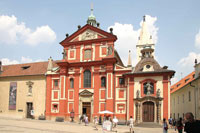
St. George's Basilica (Czech: Bazilika Sv. Jiří) is the oldest surviving church building within Prague Castle, Prague, Czech Republic. The basilica was founded by Vratislaus I of Bohemia in 920. It is dedicated to Saint George.
The basilica was substantially enlarged in 973 with the addition of the Benedictine St. George's Abbey. It was rebuilt following a major fire in 1142. The Baroque façade dates from the late 17th century. A Gothic style chapel dedicated to Ludmila of Bohemia holds the tomb of the saint. The shrines of Vratislav and Boleslaus II of Bohemia are also in the basilica. …
Lire la suite
Église Saint-Nicolas (Kostel svatého Mikuláše)
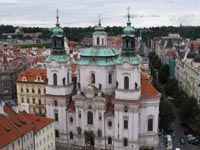
Though smaller and not as rich as the Cathedral of St. Nicholas from the Lesser Town, The Church of St. Nicholas in the Old Town Square plenty deserves its place among Prague’s most appreciated and visited places. If you just think about the eight centuries that it has stood and faced the wickedness of the history you come to look at it in a totally different way.
History
Historical sources mention this place of worship as early as 1273, originally as a parish church, where Hussitism and Reformation used to be preached. Later in the 17th century the church fell into Benedictine …
Lire la suite
Église Saint-Nicolas (Chrám svatého Mikuláše)
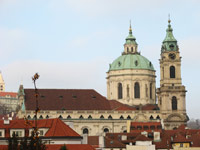
St. Nicholas Church (Cathedral) (Chrám svatého Mikuláše) from the Lesser Quarter in Prague has put its name into Czech and European Baroque era and is now Prague number one church of this kind. Its history is linked to Czech re-catholisation process that followed the defeat of the Hussites in the Battle of the White Mountain (1620).
The beginnings of the imposing Cathedral that we see today go back to the year 1283, when the place of worship started its existence as a parish church under the name and protection of St. Nicholas. With the change of authority in the 17th century, Baroque era …
Lire la suite
Black Tower (Černá věž)
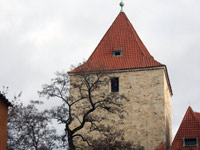
The Black Tower is one of the oldest existing buildings in Prague. It was built in 1135 as an eastern gate of the Romanesque fortification of Prague Castle. You can still see the former gateway on the ground floor, but it is walled up now.
Origin of the name "Black Tower"
The Black Tower belongs to the area of the Supreme Burgrave's House at Prague Castle. Its name "Black" originates from the time of the big fire of Prague Castle in 1541 - its walls remained black for a long time.
However, the tower was called "Golden" in the era of Emperor Charles IV in the 14th century because of its …
Lire la suite
Vysehrad (Vyšehrad)
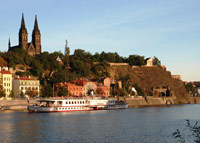
Vysehrad is a castle located in the city of Prague, Czech Republic. It was probably built in the 10th century, on a hill over the Vltava River. Situated within the castle is the Basilica of St Peter and St Paul, as well as the Vysehrad Cemetery, containing the remains of many famous people from the Czech history, among them Antonín Dvořák, Bedřich Smetana and Karel Čapek.
Local legend holds that Vysehrad was the location of the first settlement which would later become Prague, though thus far this claim remains unsubstantiated.
History
When the Přemyslid dynasty settled on the current …
Lire la suite
Eglise Notre-Dame de la Victoire (Kostel panny Marie Vítězné)
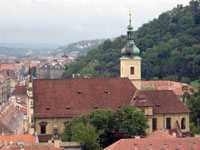
The Church of Our Lady Victorious (Czech: Kostel Panny Marie Vítězné) in Malá Strana, the "small side" of Prague is a Carmelite church and the home of the statue called the "Infant Jesus of Prague".
A chapel dedicated to the Holy Trinity was built on this site in 1584. With the Battle of White Mountain, 8 November 1620, the Counter-Reformation signalled the re-Catholicisation of Prague. The church was given to the direction of the Carmelites in September 1624. The triumphalist altarpiece of Our Lady of Victory was sent from Rome by Pope Gregory XV. The Carmelites were ordered to hand over …
Lire la suite
Place de Mala Strana (Malostranské náměstí)
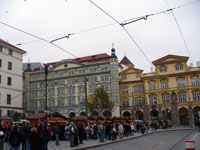
Since it was laid out in 1257, this square has been the heart of Lesser Town (Czech: Malá Strana), a district situated at the foot of the Prague Castle. The square is dominated by St. Nicholas Church, a impressive baroque church that occupies the center of the square.
Magnificent houses with Renaissance and Baroque façades border Lesser Town Square (Czech: Malostranské náměstí) on all sides. During the Middle Ages, when the square was the site of a market for the Prague Castle, the buildings had Gothic designs. A fire that broke out at the square destroyed most of the houses and they were …
Lire la suite
Petrin (Petřín)
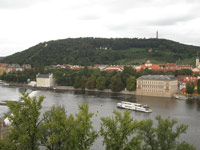
Petřín (327 m) is a hill in the center of Prague, Czech Republic. It rises some 130 m above the left bank of the Vltava River. The hill, almost entirely covered with parks, is a favorite recreational area for the inhabitants of Prague. The hill (in German known as Laurenziberg) is featured prominently in Franz Kafka's early short story "Description of a Struggle" and briefly in Milan Kundera's novel The Unbearable Lightness of Being.
The summit of the hill is linked to Prague's Malá Strana district by the Petřín funicular, a funicular railway that first operated in 1891.
Lire la suite
Opérateur
- Téléphone: +420 261 264 369
- E-mail: info@arcadira.eu
Information touristique
Tourist Information about Prague and Czech republic. History, Culture, Language, Currency, Visa and much more.
Liste des hôtels à Prague
Prague hôtels 3 *
- Botel Albatros
- Botel Florentina
- Botel Racek
- Hotel Ankora
- Hotel Arbes - Mepro
- Hotel Atos
- Hotel Donatello
- Hotel Globus
- Hotel Gloria
- Hotel ILF
- Hotel Legie
- Hotel Old Prague
- Hotel Olsanka
- Hotel Olympik Tristar
- Hotel Victoria
- King George´s House
Prague hôtels 4 *
- Hotel Adria
- Hotel Amigo
- Hotel Arkada
- Hotel Barceló
- Hotel Barceló Old Town
- Hotel Caesar Palace
- Hotel Corinthia Panorama
- Hotel Golf
- Hotel Holiday Inn Congress Centre
- Hotel Louis Leger
- Hotel Majestic Plaza
- Hotel Olympik
- Hotel Pyramida
- Hotel Roma
- Hotel Step
- Hotel U Krále Karla
- Hotel U Páva
- Hotel Yasmin
Prague hôtels 5 *
Contact
- Pragap Tour, s.r.o. (Arcadira)
- Liliová 10
- 110 00, Praha 1
- Česká republika
- Téléphone: +420 261 264 369
- Fax: +420 244 400 157
- Adresse électronique: info@arcadira.eu
- Facebook: www.facebook.com
- ICO: 25147412
- DIC: CZ25147412
© 2008-2024 Pragap Tour, s r.o. (Arcadira) | Tous droits réservés | Conditions commerciales | Created by Jaroslav Salivar